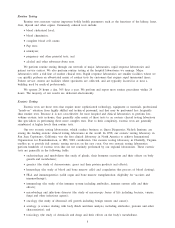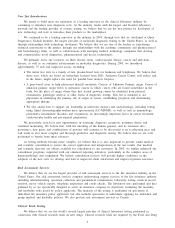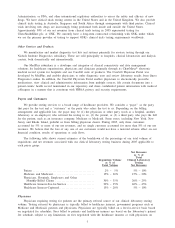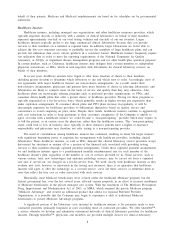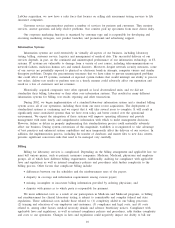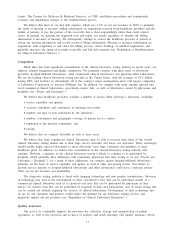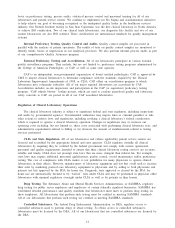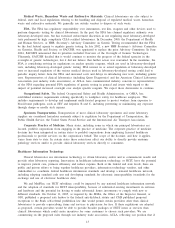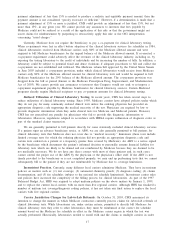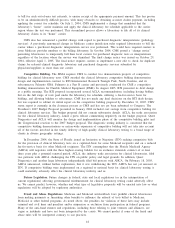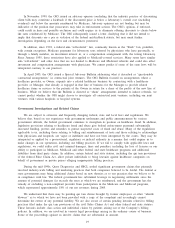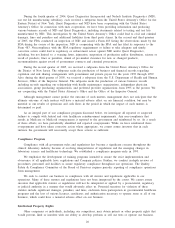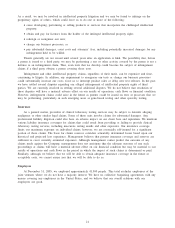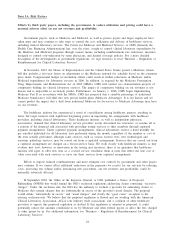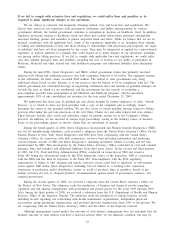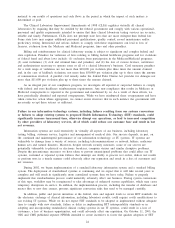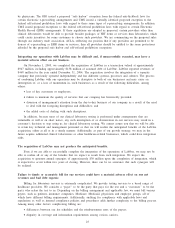Quest Diagnostics 2005 Annual Report Download - page 32
Download and view the complete annual report
Please find page 32 of the 2005 Quest Diagnostics annual report below. You can navigate through the pages in the report by either clicking on the pages listed below, or by using the keyword search tool below to find specific information within the annual report.fee-for-service claim transactions and our electronic fee-for-service remittance transactions. In September 2005,
as part of HIPAA Administrative Simplification, HHS published a Notice of Proposed Rulemaking on Standards
for Electronic Health Care Claims Attachments. We are commenting on this proposal through ACLA, our
industry trade association, and final rule publication from HHS is not anticipated prior to mid-2006. Upon final
rule publication, the implementation period for electronic health care claim attachments is anticipated to be two
years at a minimum.
The HIPAA transaction standards are complex and subject to differences in interpretation by payers. For
instance, some payers may interpret the standards to require us to provide certain types of information,
including demographic information not usually provided to us by physicians. We are working closely with our
payers to establish acceptable protocols for claims submissions and with our industry trade association and an
industry coalition to present issues and problems as they arise to the appropriate regulators and standards setting
organizations.
Regulation of Reimbursement for Clinical Laboratory Services
Overview. The healthcare industry has experienced significant changes in reimbursement practices during
the past several years. Government payers, such as Medicare (which principally serves patients 65 years and
older) and Medicaid (which principally serves indigent patients), as well as private payers and large employers,
have taken steps and may continue to take steps to control the cost, utilization and delivery of healthcare
services, including clinical laboratory services. If we cannot offset additional reductions in the payments we
receive for our services by reducing costs, increasing test volume and/or introducing new procedures, it could
have a material adverse impact on our net revenues and profitability.
While the total cost to comply with Medicare administrative requirements is disproportionate to our cost to
bill other payers, average Medicare reimbursement rates are not materially different than our overall average
reimbursement rate from all payers, making this business generally less profitable. Despite the added cost and
complexity of participating in the Medicare and Medicaid programs, we continue to participate in such programs
because we believe that our other business may depend, in part, on continued participation in these programs,
since certain customers may want a single laboratory capable of performing all of their clinical laboratory
testing services, regardless of who pays for such services.
Billing and reimbursement for clinical laboratory testing is subject to significant and complex federal and
state regulation. Penalties for violations of laws relating to billing federal healthcare programs and for violations
of federal fraud and abuse laws include: (1) exclusion from participation in Medicare/Medicaid programs;
(2) asset forfeitures; (3) civil and criminal fines and penalties; and (4) the loss of various licenses, certificates
and authorizations necessary to operate some or all of a clinical laboratory’s business. Civil monetary penalties
for a wide range of violations are not more than $10,000 per violation plus three times the amount claimed
and, in the case of kickback violations, not more than $50,000 per violation plus up to three times the amount
of remuneration involved. A parallel civil remedy under the federal False Claims Act provides for damages not
more than $11,000 per violation plus up to three times the amount claimed.
Reduced Reimbursements. In 1984, Congress established a Medicare fee schedule payment methodology
for clinical laboratory services performed for patients covered under Part B of the Medicare program. Congress
then imposed a national ceiling on the amount that carriers could pay under their local Medicare fee schedules.
Since then, Congress has periodically reduced the national ceilings. The Medicare national fee schedule
limitations were reduced in 1996 to 76% of the 1984 national median of the local fee schedules and in 1998 to
74% of the 1984 national median. The national ceiling applies to tests for which limitation amounts were
established before January 1, 2001. For more recent tests (tests for which a limitation amount is first established
on or after January 1, 2001), the limitation amount is set at 100% of the median of all the local fee schedules
established for that test in accordance with the Social Security Act. The MMA eliminated for five years
(beginning January 1, 2004) the provision for annual increases to the Medicare national fee schedule based on
the consumer price index. Thus, by law an adjustment to the national fee schedule for clinical laboratory
services based on the consumer price index cannot occur before January 1, 2009. However, the MMA added
coverage for certain cardiovascular screening tests and diabetes screening tests, subject to certain frequency
limitations. The MMA evaluates new diagnostic tests for coverage as they are introduced. In addition, the 2005
Physician Fee Schedule rule proposed to lower Medicare’s payment rates for flow cytometry services in 2005.
Quest Diagnostics believed that CMS failed to properly value these services and commented on this proposed
change through ACLA. Pathology services are reimbursed by Medicare according to a Physician Fee Schedule
based on a resource-based relative value scale, or RBRVS, that is periodically updated by CMS. On
15


